Congratulations on completing this chapter, where the skills and knowledge required to build a Twitter clone, nicknamed Tweety, were discussed in detail. This chapter started off by explaining what an Angular frontend application is and how the MVVM pattern can benefit both in terms of development and maintenance. We talked about the requirements for the backend and frontend to be developed and used a Unified Modeling Language (UML) use case diagram to explain the requirements visually.
This chapter also talked about how to understand the domain model of an application, based on requirements (Tweety), and how to use Spring Data JPA to convert those domain models into entities in an H2 database. A UML class diagram was used to explain the domain model in detail.
Furthermore, this chapter explained how to write data repositories for documents using the Spring Data JPA with minimum effort using common CRUD operations. Next, we explained how to write custom query methods in data repositories. We also explained how to encapsulate business logic inside Spring Service components, and some caveats to provide reactive capabilities with non-reactive data layers.
Subsequently, this chapter talked about how to write presentation views to list tweets and create a tweet using the Angular Framework. We also explained how to use Angular Material syntax to develop pages.
Near the end of this chapter, we talked about how to use Spring WebFlux controllers to provide routing and coordinating for different services. Furthermore, we talked about how to protect controller endpoints using Spring Security OAuth2 to allow the proper authentication and authorization of users. This chapter also demonstrated the use of Tweety in detail. Let's learn more about some interesting features of Spring Boot 2.0 in the following chapters.
